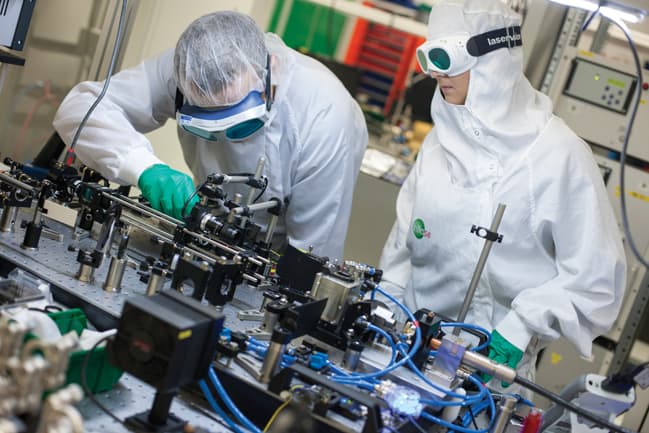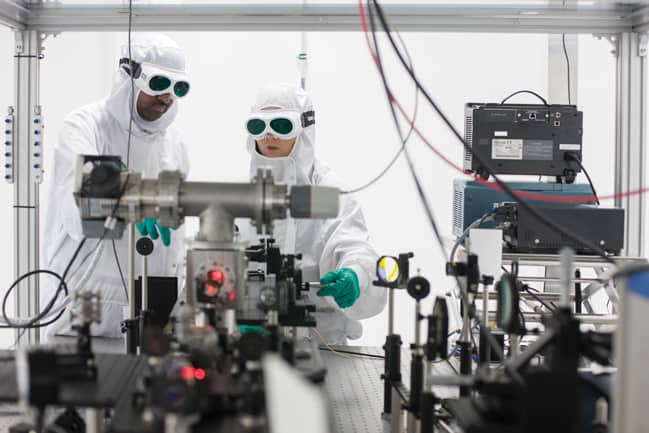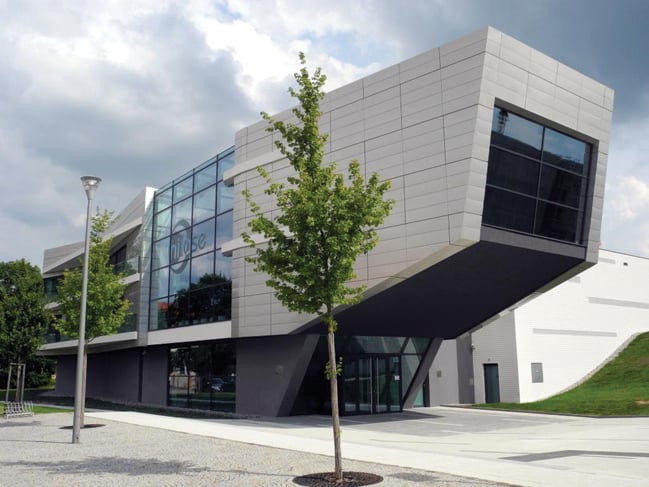In Dolní Brežany, excited physicists are preparing to receive their new £10m super toy. The machine is a diode-pumped solid state laser (DPSSL) with special properties that they hope will justify the European Commission’s €33m (£24m) investment in a new research centre, bring jobs to the region and – most importantly – provide global industries such as optics and aerospace with ‘game-changing’ manufacturing techniques.

The laser, to be delivered in May, will help the new facility, known as HiLASE, become one of Europe’s centres of excellence for laser research in a partnership with the UK Science & Technology Facilities Council (STFC).
The HiLASE Centre will be operated by the prestigious Czech Institute of Physics and completed in mid-2014. The new machine is called DiPOLE – or Diode Pumped Optical Laser for Experiments – and was designed and manufactured by the Central Laser Facility (CLF), based at the Rutherford Appleton Laboratory in Harwell, part of the STFC.
To be precise, the 100J, 10Hz laser was built by CALTA – the Centre for Advanced Laser Technology Applications, a division of CLT – and while it has pan-European suppliers the machine is all British.
Lasers have wide industrial applications, and new technology such as the diode-pumped laser brings new, exciting applications. With a lack of laser research to support industry in the Czech Republic, the four-year HiLASE project was commissioned in 2011 and should be fully operational by January 2016, according to Dr Tomas Mocek of the Institute of Physics.
“We started HiLASE to support big laser infrastructure such as ELI and also to satisfy demand from industry, locally and European,” he said. The Czech component of ELI – the Extreme Light Infrastructure project – is next door. Clearly serious about its laser strategy, the Czech Republic needed some special hardware.
Enter CALTA at the Rutherford Appleton Lab’s Central Laser Facility and its ingenious device. There are two principle modes of operation for lasers, under which sit laser categories such as gas solid state, fibre and so on – they are continuous wave and pulsed. Pulsed operation has several types and the DPSSL at CALTA is pulsed in the picosecond and nanosecond regimes. The key to the technology is to combine high peak power with high repetition rate.
“Currently you can buy either high-peak-power lasers, i.e. a small energy in a very short time, which tend to be flash lamp pumped, or a high-repetition machine,” said Dr Ric Allott, business development manager at the Central Laser Facility.

“This new DiPOLE laser we have built can generate very high pulse energies and we can run it at 10Hz, or 10 shots per second, repetition.” This gives users a more reliable and efficient process (see box).
Much of the laser industry is in transition from traditional flash lamp pump technology to diode pumping, according to Mocek. “This [DPSSL] is very efficient and compact, but still very expensive for companies that need a quick return on investment.” This provides the need for a research centre such as HiLASE.
DiPOLE has several big commercial applications, including micro-machining, cutting, welding, removal of deposits and laser peening.
Laser shock peening (LSP) is a relatively new technology that hardens materials. Aircraft, for example, have critical parts that require treatment after a certain number of flying hours or they are subject to cracking. Shot peening – spraying the material with projectiles – is traditionally deployed. By changing the residual stress in the surface by imposing shock, you can revitalise the material surface, and this can increase the part’s lifetime.
But shot peening is messy and comparatively less efficient. “With LSP, first it is easier to apply the photons than the [shot] projectiles to certain areas of an aircraft,” said Mocek. “Secondly, by using LSP, the lifetime of these parts can be extended by a factor of two or three, significantly more than shot peening.” Boeing, Airbus, Rolls-Royce and GE are all interested, Mocek said, but the technology is not certified yet.
“The key point is that the [new] laser increases throughput of work, because the energy per pulse is much higher and the repetition rate is much higher than existing laser techniques,” said Allott. Laser peening is currently a circa $200m (£135m) a year business with about 15 per cent growth, according to figures quoted by the STFC.
Another application is laser-induced damage threshold measurements for the optics industry. Lenses and mirrors in industry have to be resistant, and a laser-induced damage threshold test (LIPT), with an ISO standard, can be used. But the facilities that provide this are few in number. “Major manufacturers of optics need a lab to measure their optics and tell them this new layer they’ve developed has a defined damage threshold,” said Mocek. “It’s essential information for their customers so that they can improve their process.”
The partners are excited about the potential for this technology. The CLF will look to shorten the pulse of the laser to generate radiation, which is good for imaging and non-destructive testing. “The key to this is because the pulse lengths of the source that you generate are so short, you can freeze the image on a part that is moving,” said Allott. Consider testing the integrity of turbine blades while they are rotating.
CALTA is building another 100J, 10Hz DiPOLE laser for the European XFEL project at DESY in Hamburg, and there is further interest in DPSSLs from labs elsewhere.

In the last 15 years, some 12 companies have been spun out from the laser facilities at the Rutherford Appleton Laboratory. “In the future, should the demand be there, we would consider the possibility of a spin-out or JV [joint venture] company to build these [DiPOLE] lasers. We have a history of spin-out companies, the latest success being Cobalt Light Systems,” said Allott. Cobalt Light Systems won the 2014 MacRobert Award and its invention is now deployed in several airports to detect the chemical composition of liquids while stored in baggage.
The future for this new technology seems bright and shows how investment in research councils can deliver real economic value.
IN DEPTH
Diode-pumped solid-state (DPSS) lasers – the technology
Lasers require a gain medium to amplify light, which needs to be supplied with energy in a process called pumping. Conventionally, this is pumped by flash lamps, such as those in a camera. “This is very inefficient – a flash lamp light is a broad spectrum and you absorb just a small part of that spectrum in the laser gain media,” said Dr Ric Allott, business manager at the Central Laser Facility.
“[In a diode pump], you are targeting the absorption in the laser gain medium with the specific wavelength given out by the diode,” he added. “The efficiency is multiple times that with flash lamp.”
The DiPOLE laser built at the UK Science & Technology Facilities Council combines high average power with high peak power.
By contrast, another large laser at Rutherford Appleton Laboratory, Vulcan, has high peak power but can only fire once every 20 minutes.
“The key with this laser is we can generate very high pulse energies but we can also run at 10Hz repetition, or 10 shots per second.
It means a 100J laser gives us 1kW of average power – that is a huge amount of average power for a laser that is also capable of delivering 10GW of peak power,” said Allott.
The high peak power is defined by the pulse length of the laser – roughly 10 nanoseconds. “So 100J delivered in 10 nanoseconds gives you 10GW of average power. That’s a special situation when you have high average power with high peak power,” he added.

Project to investigate hybrid approach to titanium manufacturing
What is this a hybrid of? Superplastic forming tends to be performed slowly as otherwise the behaviour is the hot creep that typifies hot...